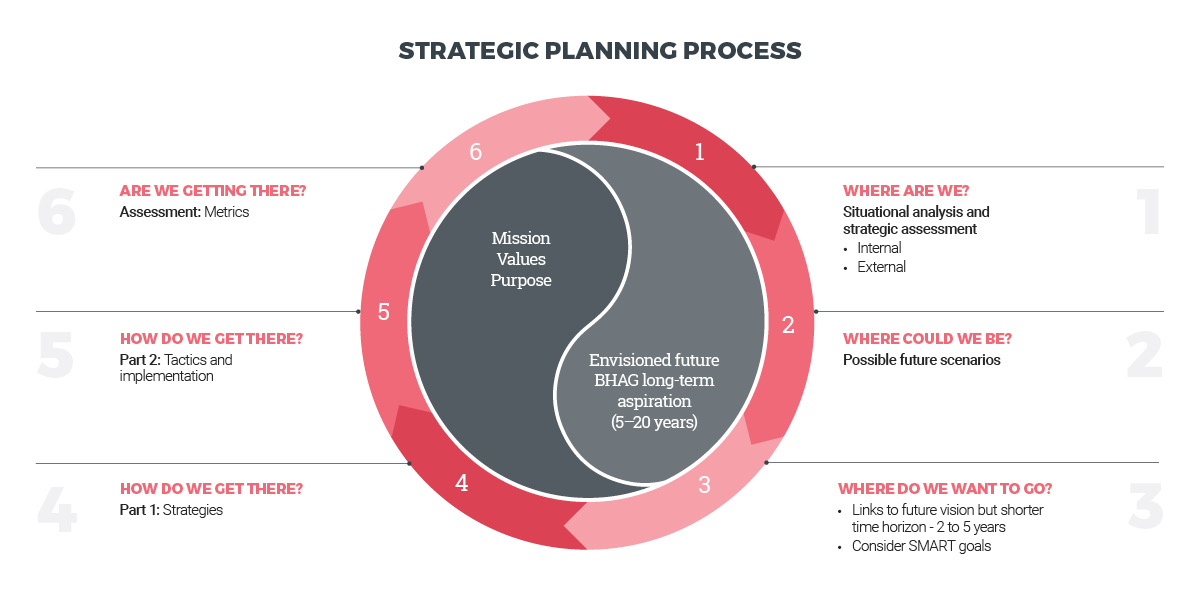After nearly a decade of facilitating and developing strategy in destination marketing, we’ve found a winning approach.
Building a multi-year destination strategy involves making clear choices about your organization’s vision, goals, mission and values. Those choices will help you define tangible actions to make your destination’s vision a reality.
Here are the six foolproof steps that we’ve refined over many years of successful destination strategic planning:
1) Where are we? Execute several modes of research and investigation to develop a situational analysis that answers this question.
Gather and review documents including annual reports, business plans, historical occupancy and tourist traffic statistics, as well as marketing performance reports, key performance metrics, organizational charts, any other research, campaign results, brand documents, industry/stakeholder documents, city government planning documents and plans from other tourism organizations or research companies.
You will also need to conduct primary research, both within the destination marketing organization (DMO) and externally, with visitors or stakeholders. This includes interviews, focus groups, surveys, consultations town hall meetings, and more. This is also the time to audit your own marketing channels and benchmark your industry’s sophistication.
At this stage, you may also need to conduct further research to fill gaps in understanding of products and experiences, including capacity analysis of accommodation, transit, air travel, city, etc.
2) Where could we be? The goal is to propose strategic options to answer this question. We try to create conservative, progressive and aggressive options.
Review and refine your organization’s vision and mission. Consider options for your destination’s strategic direction, including goals and KPIs. Then, define organizational goals and KPIs and identify requirements to meet those strategic directions.
At this stage, there are internal and external requirements:
Internal requirements
- Funding level
- Organization structure and capabilities
- Systems and processes
External requirements
- Infrastructure and capacity
- Funding model
- Dependencies on stakeholders, such as:
- Your national destination marketing organization (DMO)
- Your regional or provincial DMO
- Industry
- Government, airports and city/municipal departments
- Third-party organizations
At the end of this step, you should arrive at a set of measurable strategic objectives for each strategic direction.
You can use both an internal and external review to benchmark the current state against best practices. Conduct a trend review to find the best practices, inside and outside of the tourism industry. It is also a good idea to choose five main competitors and five examples of best practices. Create a benchmark report and a gap analysis. Use processes including stakeholder surveys; stakeholder engagement workshops and internal staff interviews.
Don’t limit yourself. After all, you’re only exploring options at this stage. Innovate by expanding on existing ideas. Or disrupt current practices by doing something completely new or different. This is the time to dream and be creative.
3) Where do we want to go? Answer this question by selecting the best direction and deciding on the best strategic options for your organization, based on step 2.
After exploring the options, you have a strategic choice to make. Where do you want to go? Factors such as your political environment, destination maturity, economic factors, skills and capacity, stakeholder sophistication and more need to guide the decision and find the right balance between risk and reward.
Be too aggressive and you might risk overpromising and underdelivering. Be too conservative and you might risk becoming irrelevant.
In our experience, the right decision comes naturally based on the previous steps in the process. It’s more important to make the decision in collaboration with your most important stakeholders. Your success is their success and your success is dependent on their support. By making your organizational goals collective goals, there’s a higher sense of ownership and buy-in.
4) How do we get there? Part 1: Strategies. By this point, your destination will have defined a clear direction. Building a detailed roadmap and the draft of the multi-year strategic plan will enable you to answer this question.
With a clear goals and measurable objectives in place, the right strategies can be created to achieve them. It’s important to involve internal and external stakeholders to continue to receive buy-in for the plan at a strategic level and feedback to help anticipate where there may be resistance. You can also validate assumptions and assess viability, to incorporate feedback into the draft strategic plan.
5) How do we get there? Part 2: Tactics & Implementation. Develop a series of tactical actions that will drive the achievement of the strategic objectives.
Once senior leadership and stakeholders are comfortable with the overarching strategic direction, tactical plans are best done in conjunction with the people and teams that will be implementing them. This typically takes the form of monthly, quarterly or annual plans.
6) Are we getting there? Monitor progress to refine your strategy.
The final step of the planning wheel involves review. As the multi-year strategic plan is put into action, objective-driven tactics would be created that allow progress to be monitored and assessed against the plan to find opportunities to improve and grow beyond what you have started.
This valuable planning tool can help you clarify your destination’s strategy. Use these six steps to generate the greatest possible impact on your visitors and tourism stakeholders.
(Credit: Marketing professional and University of British Columbia educator Paul Cubbon originally worked with us to develop the strategic planning wheel that led to this valuable approach.)










That’s a nice clear outline to creating a good strategic plan. I think a lot of people also fall over in the writing of the objectives in the plan. We wrote a piece covering this here: https://www.executestrategy.net/blog/a-guide-to-writing-strategic-objectives/
Would love to hear your thoughts on it!